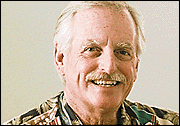


Water Ways
IF you missed last week's column, I have a good excuse for its absence. I was in California playing the part of the proud father at my daughter's wedding. Hawaii not alone with
urban runoff problemsOf course, my duties weren't so time-consuming that I didn't have time to roam the waterfront from San Diego to Long Beach and make some comparisons with our own maritime community. So, for the next few weeks, along with Hawaii's recreational boating news, I will be pointing out some of the similarities and differences I noticed during my 10-day sabbatical to the mainland.
For instance, today thousands of volunteers here have been taking part in an international program called "Get the Drift and Bag It." It is a once-a-year effort to focus on the coastal cleanup of trash and litter and, hopefully, you are reading this as you relax after doing your share in the pickup.
According to the University of Hawaii's Sea Grant Program coordinator Chris Woolaway, last year's effort attracted 4,279 volunteers who collected 227,759 pounds of debris along 153 miles of our islands' coastlines. (I would hope that smokers would be embarrassed to learn that cigarette butts were, by far, the most numerous items tallied in the cleanup.)
Along the Southern California coast, the city of Huntington Beach - sometimes called Surf City - has been wrestling with a more insidious form of pollution in the form of dangerously elevated bacteria counts in its shoreline waters. The problem was so severe that most of its beaches have been closed much of the summer and, as a result, the usual beach crowds went elsewhere.
Correspondingly, the beach closures have had a devastating effect on Huntington Beach's merchants. Just imagine how business would have been along Kalakaua Avenue if Waikiki Beach had been off limits to swimmers this summer.
The questions for us are, of course, what caused the problem and can it happen here?
Apparently, health officials there believe a sewage spill created the first high bacteria levels in July. After that, the levels remained at an unsafe level due to a growing source of ocean contamination from urban runoff - water flowing from streets and gutters, into storm drains, and then into the ocean. Such runoff carries with it all of the pollutants found in a residential environment, from fertilizers and animal wastes to petroleum products and pesticides.
WITHOUT question, waterways such as the Ala Wai Canal funnel the same sort of toxic soup out to the ocean, but so far, the concentrations have been at more acceptable levels and tend to flow out to sea rather than back to our beaches.
To counter the problem in Huntington Beach, teams of engineers worked for weeks to determine the source of the pollution. More than $400,000 was spent for drilling and using offshore sonar and ground-penetrating radar in the search.
According to one report, officials even went so far as to divert the urban runoff to a sewage treatment plant. And although some sanitation engineers warn that runoff and sewage pipelines should not be combined, another coastal city, Laguna Beach, now handles 38 percent of its dry season runoff through its sewage treatment plant.
Locally, the Ala Wai Canal Watershed Improvement Project organization and others, are finding ways to lessen the impact of urban runoff. But ultimately, it will require the commitment of the entire community before we will ever see major positive changes.
Ray Pendleton is a free-lance writer based in Honolulu.
His column runs Saturdays in the Star-Bulletin.
He can be reached by e-mail at raypen@compuserve.com.